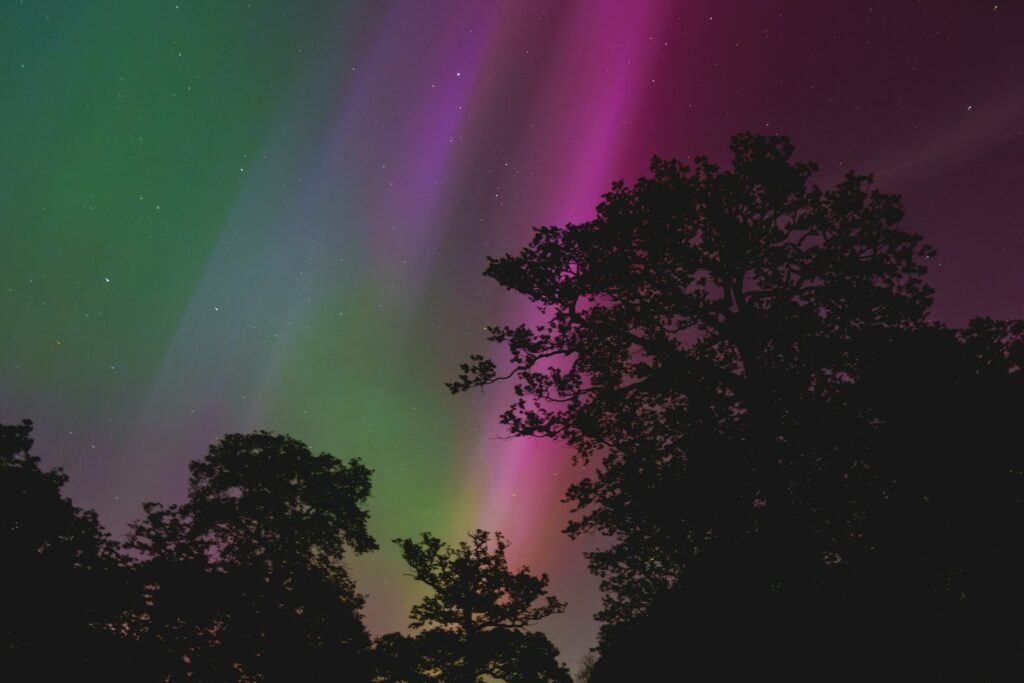It began as a faint blush above the Continental Divide, a rose-colored ribbon that refused to behave like sunset or city light. Within minutes, phones came out, porch lights went off, and atmospheric scientists across the Front Range pivoted their cameras to the same patch of sky. The glow held steady, then sharpened into a luminous band arcing from northwest to southeast, as if someone had traced a high-altitude highway with neon chalk. Early reports hinted at a rare light event normally reserved for higher latitudes, yet this display hovered over the Rockies like it had every right to be there. The mystery deepened, and with it a chance to learn how Earth’s upper atmosphere breathes when the Sun turns up the volume.
The Hidden Clues

What turns a mountain night sky pink when there’s no storm on the ground and no wildfire nearby to color the haze? The first clue is altitude: the glow didn’t pool near the horizon like a distant town, and it didn’t flicker like lightning or aircraft traffic. Instead, it hung in the subauroral sky, the zone just equatorward of typical aurora, a place where space weather can surprise mid-latitude watchers. I stepped onto my own back deck near Boulder and felt that strange, thrilled hush you get when nature breaks its own rules. The color wasn’t red like familiar auroras or green like the classic curtains; it was purple-violet, the distinctive shade characteristic of STEVE phenomena.
That unusual tint pointed scientists toward a pair of suspects: a subauroral phenomenon known as STEVE and its frequent sidekick, a stable auroral red arc that can burn crimson into the night. The pinkness suggests accelerated particles and upper-atmospheric heating in a narrow channel, not the dancing sheets most people picture when they hear “aurora.” It’s more like a plasma river than a curtain, focused and fast. And crucially, it can appear far south of the auroral oval when the geospace environment is just right. That’s why a Rocky Mountain glow can feel both out of place and exactly on time during an active solar cycle.
Inside the Pink: What Scientists Think Is Happening

STEVE, short for Strong Thermal Emission Velocity Enhancement, isn’t your typical aurora; it’s a signature of intense, fast-moving ions and electrons sliding along magnetic field lines in the subauroral ionosphere. The purple-violet color likely comes from a mix of emissions, including nitrogen features and continuum light driven by energetic heating, while the companion red arc tracks excited oxygen at high altitude. Think of it as a cosmic heat streak, a high-altitude shortcut where energy drains from space into the upper atmosphere. Unlike broad auroras, which can ripple and dance across hundreds of miles, STEVE often presents as a clean, knife-edge band. It moves fast, shows up without the usual green, and sometimes sprinkles a “picket fence” of vertical striations along its path.
Over the Rockies, instruments that watch for these emissions – imaging spectrometers, sensitive all-sky cameras, and GPS-based maps of electron content – help decode the blend of colors. When the solar wind shakes Earth’s magnetic tail, subauroral flows can light up like a highway at rush hour. That’s when the pink arrives, not as a guarantee, but as a telltale of a system dumping energy where we don’t often expect it. If you’ve ever watched a river carve a shortcut after a flood, you’ve glimpsed the logic at work. The flow finds the fastest path, and the sky leaves a luminous receipt.
From Ancient Tools to Modern Science

We’ve been noting strange lights for centuries, from winter storytellers describing crimson arcs to early telegraph operators cursing geomagnetic jitters. Back then, all anyone could do was remember, compare, and wonder. Today, the toolkit spans the ground to orbit: photometers that count photons like raindrops, magnetometers that feel the faint tug of currents overhead, and satellites that read the solar wind like a forecast. We can time-synchronize camera arrays across counties and line up their frames with satellite passes to see cause and effect unfold. In that sense, the Rockies have become a laboratory ceiling – spacious, dark, and surprisingly talkative.
Citizen observers, too, have changed the game. A neighbor’s backyard camera can catch the moment a picket fence pops, and a hiker’s long-exposure shot can reveal structure the eye barely sensed. When those images reach scientists in real time, they stitch together a multi-angle movie of a fleeting event. It’s the same thrill as birders logging a rare migration, only the flock in this case is a ribbon of energized particles rushing over the spine of the West. The data, both casual and calibrated, tighten the mystery into a testable story.
On the Ridge with the Trackers

Field teams fanned out along the foothills, loading compact spectrometers beside tripods and battery packs, then calling out coordinates over group chats as the band shifted. They didn’t chase lightning or dodge rain; they chased a moving altitude, watching the glow’s geometry change with each minute. Models predicted a window when the subauroral flow might intensify, so they framed the sky like photographers anticipating a fleeting beam of sun through storm clouds. Meanwhile, a bank of computers in Boulder pulled down satellite readings of ion drift and electron density. It was a cross-country relay race in the dark, and the baton was information.
I tagged along with one crew for an hour and learned the art of looking twice. The first glance says pretty; the second says physics. A dull camera histogram can hide a sharp spectral line, and a seemingly uniform band can reveal a fine comb of vertical streaks after processing. That’s when disagreements become productive: is a shift in color a true change aloft or a trick of camera sensitivity? Each answer feeds the next observation plan, and the pink arc becomes less of a miracle and more of a measurement waiting to happen.
Why It Matters

Pink skies are mesmerizing, but they’re also diagnostics for the way our planet handles solar energy. Traditional auroras have long anchored our models of geospace energy transfer, yet subauroral events like STEVE poke holes in the old boundaries and force updates. When energy dumps farther south, satellites feel it as extra drag, radio links wobble, and high-frequency navigation gets fuzzy. That ripple of consequence moves from the upper atmosphere down to the systems we use every day. In a busy solar cycle, surprises become part of the forecast, not the exception.
Consider the practical ripples during an active night:
- Increased atmospheric heating can raise orbital drag, nudging satellites to adjust sooner than planned.
- HF communications and GPS accuracy can wobble as ionospheric structure sharpens and shifts.
- Power grid operators watch for geomagnetically induced currents, even at mid-latitudes, to keep transformers safe.
Subauroral pink isn’t just pretty; it’s a blinking indicator that Earth is negotiating with space in real time, and sometimes rewriting the rules on the fly.
Global Perspectives

Colorado’s glow joins a growing gallery of mid-latitude sightings from Canada’s prairies to Scotland and New Zealand, each one adding a datapoint to a planet-scale puzzle. Some nights, the band runs razor-thin; other nights, a red arc flanks it like a warning light. Geography matters, but magnetic geometry matters more, which is why similar events can appear oceans apart on the same evening. The Rockies offer altitude and dark skies; the global community offers coverage across time zones. Together they build a fuller map of where subauroral energy prefers to go when the solar wind picks up.
International collaborations make this map actionable. Ground stations share timing stamps with satellites that see the same region from space, while community science networks sift social posts for verified images and locations. That feedback loop spreads quickly during solar peaks, turning scattered awe into a coordinated record. It’s a reminder that while the sky feels local – your backyard, your ridge, your town – it’s stitched to a magnetic system that writes its story on a global canvas. The pink arc is merely a bright, timely signature.
The Future Landscape

Forecasting rare sky glows is shifting from art toward science as new tools come online. Machine learning models already scan thousands of night-sky frames to flag candidate events, while improved geomagnetic forecasts narrow the hours when subauroral flows tend to flare. Next-generation imagers will capture spectra and polarization together, giving physicists a richer fingerprint of the particles involved. On orbit, constellations can ride the same air-drag pulses we measure from the ground, letting teams test predictions within a single evening. The dream is not just to explain last night but to alert observers before the glow appears.
Challenges remain. We need more calibrated sensors at altitude, better coverage over mountain terrain, and robust ways to separate camera artifacts from true color shifts. Data sharing must keep pace with the speed of social reporting, without swamping researchers in noise. And even with perfect tools, the upper atmosphere is a living system, full of eddies and shortcuts that refuse tidy boxes. That’s part of the charm and the challenge: progress will come, but on nature’s timeline.
How You Can Help

If the sky turns odd over your neighborhood, you can contribute without leaving the driveway. Step outside, shield your lights, and let your eyes adjust; if you have a camera, shoot wide with short exposures and note your location and time as precisely as you can. Submit images to community science projects that verify reports and share them with research teams tracking subauroral activity. Avoid chasing storms into risky terrain or interfering with professional sites, and resist the urge to over-process images; the science lives in the details. Think of yourself as a careful witness, not a special-effects artist, and you’ll give the data its best chance to speak.
Small choices also help scientists see more clearly. Reduce unnecessary outdoor lighting, especially during active solar periods, and ask local parks to consider dark-sky guidelines. Follow trusted space-weather updates and share them with friends who might step outside at the right moment. Support university observatories and nonprofits that maintain all-sky cameras and open datasets. The pink arc will come and go, but a community ready to notice it can turn a fleeting wonder into lasting knowledge.

Suhail Ahmed is a passionate digital professional and nature enthusiast with over 8 years of experience in content strategy, SEO, web development, and digital operations. Alongside his freelance journey, Suhail actively contributes to nature and wildlife platforms like Discover Wildlife, where he channels his curiosity for the planet into engaging, educational storytelling.
With a strong background in managing digital ecosystems — from ecommerce stores and WordPress websites to social media and automation — Suhail merges technical precision with creative insight. His content reflects a rare balance: SEO-friendly yet deeply human, data-informed yet emotionally resonant.
Driven by a love for discovery and storytelling, Suhail believes in using digital platforms to amplify causes that matter — especially those protecting Earth’s biodiversity and inspiring sustainable living. Whether he’s managing online projects or crafting wildlife content, his goal remains the same: to inform, inspire, and leave a positive digital footprint.




